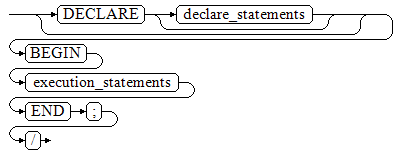DECLARE
Description
DECLARE defines a cursor to retrieve a small number of rows at a time out of a larger query and can be the start of an anonymous block.
This section describes usage of cursors. The usage of anonymous blocks is available in BEGIN.
To process SQL statements, the stored procedure thread assigns a memory segment to store context association. Cursors are handles or pointers pointing to context regions. With cursors, stored procedures can control alterations in context regions.
Generally, CURSOR and SELECT both have text returns. Since data is stored in binary format in the system, the system needs to convert the data from the binary format to the text format. If data is returned in text format, client applications need to convert the data back to the binary format for processing. FETCH implements conversion between binary data and text data.
Precautions
- CURSOR is used only in transaction blocks.
- Binary cursors should be used carefully. Text usually occupies larger space than binary data. A binary cursor returns internal binary data, which is easier to operate. A text cursor returns text, which is easier to retrieve and therefore reduces workload on the client. As an example, if a query returns a value of one from an integer column, you would get a string of 1 with a default cursor, whereas with a binary cursor you would get a 4-byte value containing the internal representation of the value (in big-endian byte order).
Syntax
- Define a cursor.
DECLARE cursor_name [ BINARY ] [ NO SCROLL ] CURSOR [ { WITH | WITHOUT } HOLD ] FOR query;
- Enable an anonymous block.
[DECLARE [declare_statements]] BEGIN execution_statements END; /

Parameters
- cursor_name
Specifies the name of the cursor to be created.
Value range: a string. It must comply with the naming convention.
- BINARY
Causes the cursor to return data in binary rather than in text format.
- NO SCROLL
Specifies how the cursor retrieves rows.
- NO SCROLL: specifies that the cursor cannot be used to retrieve rows in a nonsequential fashion.
- Unspecified: Based on the query's execution plan, the system automatically determines whether the cursor can be used to retrieve rows in a nonsequential fashion.
- WITH HOLD
WITHOUT HOLD
Specifies whether the cursor can continue to be used after the transaction that created it successfully commits.
- WITH HOLD: The cursor can continue to be used after the transaction that created it successfully commits.
- WITHOUT HOLD: The cursor cannot be used outside of the transaction that created it.
- If neither WITH HOLD nor WITHOUT HOLD is specified, the default is WITHOUT HOLD.

- For a cursor declared as WITH HOLD, all data of the cursor is cached when a transaction ends. If the cursor has a large amount of data, this process may take a long time.
- query
Uses a SELECT or VALUES clause to specify the rows to be returned by the cursor.
Value range: SELECT or VALUES clause
- declare_statements
Declares a variable, including its name and type, for example, sales_cnt int.
- execution_statements
Specifies the statement to be executed in an anonymous block.
Value range: an existing function name
Examples
For details about how to define a cursor, see Examples in section "FETCH."
Feedback
Was this page helpful?
Provide feedbackThank you very much for your feedback. We will continue working to improve the documentation.See the reply and handling status in My Cloud VOC.
For any further questions, feel free to contact us through the chatbot.
Chatbot





